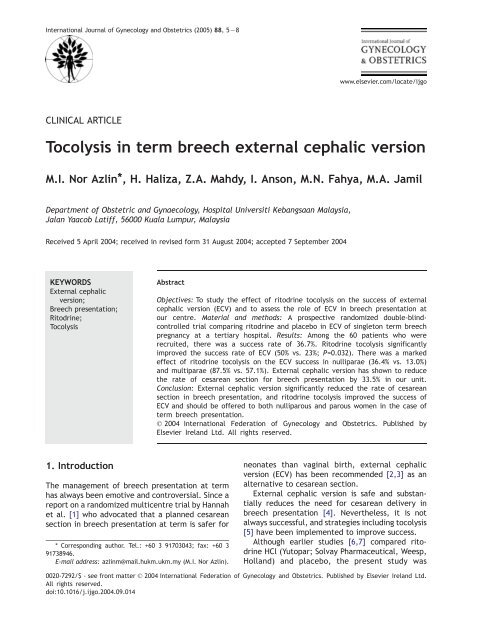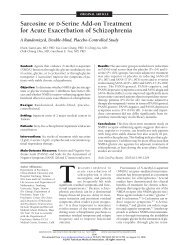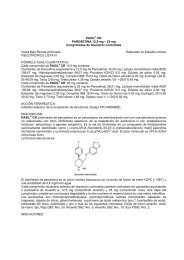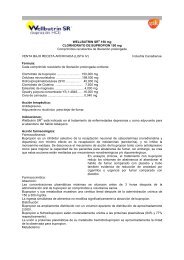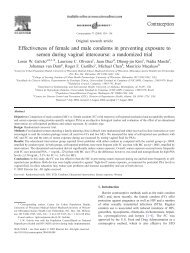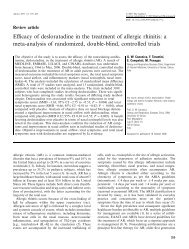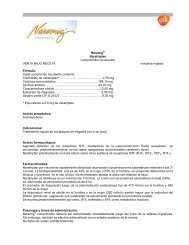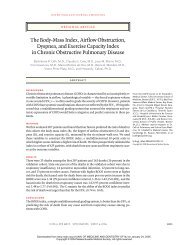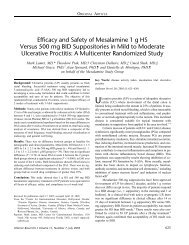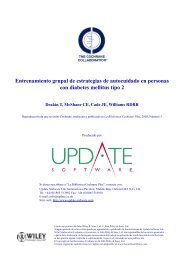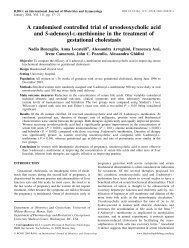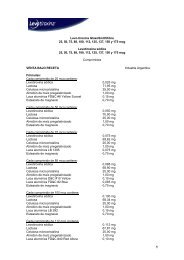Tocolysis in term breech external cephalic version - Rima
Tocolysis in term breech external cephalic version - Rima
Tocolysis in term breech external cephalic version - Rima
Create successful ePaper yourself
Turn your PDF publications into a flip-book with our unique Google optimized e-Paper software.
International Journal of Gynecology and Obstetrics (2005) 88, 5—8<br />
www.elsevier.com/locate/ijgo<br />
CLINICAL ARTICLE<br />
<strong>Tocolysis</strong> <strong>in</strong> <strong>term</strong> <strong>breech</strong> <strong>external</strong> <strong>cephalic</strong> <strong>version</strong><br />
M.I. Nor Azl<strong>in</strong>*, H. Haliza, Z.A. Mahdy, I. Anson, M.N. Fahya, M.A. Jamil<br />
Department of Obstetric and Gynaecology, Hospital Universiti Kebangsaan Malaysia,<br />
Jalan Yaacob Latiff, 56000 Kuala Lumpur, Malaysia<br />
Received 5 April 2004; received <strong>in</strong> revised form 31 August 2004; accepted 7 September 2004<br />
KEYWORDS<br />
External <strong>cephalic</strong><br />
<strong>version</strong>;<br />
Breech presentation;<br />
Ritodr<strong>in</strong>e;<br />
<strong>Tocolysis</strong><br />
Abstract<br />
Objectives: To study the effect of ritodr<strong>in</strong>e tocolysis on the success of <strong>external</strong><br />
<strong>cephalic</strong> <strong>version</strong> (ECV) and to assess the role of ECV <strong>in</strong> <strong>breech</strong> presentation at<br />
our centre. Material and methods: A prospective randomized double-bl<strong>in</strong>dcontrolled<br />
trial compar<strong>in</strong>g ritodr<strong>in</strong>e and placebo <strong>in</strong> ECV of s<strong>in</strong>gleton <strong>term</strong> <strong>breech</strong><br />
pregnancy at a tertiary hospital. Results: Among the 60 patients who were<br />
recruited, there was a success rate of 36.7%. Ritodr<strong>in</strong>e tocolysis significantly<br />
improved the success rate of ECV (50% vs. 23%; P=0.032). There was a marked<br />
effect of ritodr<strong>in</strong>e tocolysis on the ECV success <strong>in</strong> nulliparae (36.4% vs. 13.0%)<br />
and multiparae (87.5% vs. 57.1%). External <strong>cephalic</strong> <strong>version</strong> has shown to reduce<br />
the rate of cesarean section for <strong>breech</strong> presentation by 33.5% <strong>in</strong> our unit.<br />
Conclusion: External <strong>cephalic</strong> <strong>version</strong> significantly reduced the rate of cesarean<br />
section <strong>in</strong> <strong>breech</strong> presentation, and ritodr<strong>in</strong>e tocolysis improved the success of<br />
ECV and should be offered to both nulliparous and parous women <strong>in</strong> the case of<br />
<strong>term</strong> <strong>breech</strong> presentation.<br />
D 2004 International Federation of Gynecology and Obstetrics. Published by<br />
Elsevier Ireland Ltd. All rights reserved.<br />
1. Introduction<br />
The management of <strong>breech</strong> presentation at <strong>term</strong><br />
has always been emotive and controversial. S<strong>in</strong>ce a<br />
report on a randomized multicentre trial by Hannah<br />
et al. [1] who advocated that a planned cesarean<br />
section <strong>in</strong> <strong>breech</strong> presentation at <strong>term</strong> is safer for<br />
* Correspond<strong>in</strong>g author. Tel.: +60 3 91703043; fax: +60 3<br />
91738946.<br />
E-mail address: azl<strong>in</strong>m@mail.hukm.ukm.my (M.I. Nor Azl<strong>in</strong>).<br />
neonates than vag<strong>in</strong>al birth, <strong>external</strong> <strong>cephalic</strong><br />
<strong>version</strong> (ECV) has been recommended [2,3] as an<br />
alternative to cesarean section.<br />
External <strong>cephalic</strong> <strong>version</strong> is safe and substantially<br />
reduces the need for cesarean delivery <strong>in</strong><br />
<strong>breech</strong> presentation [4]. Nevertheless, it is not<br />
always successful, and strategies <strong>in</strong>clud<strong>in</strong>g tocolysis<br />
[5] have been implemented to improve success.<br />
Although earlier studies [6,7] compared ritodr<strong>in</strong>e<br />
HCl (Yutopar; Solvay Pharmaceutical, Weesp,<br />
Holland) and placebo, the present study was<br />
0020-7292/$ - see front matter D 2004 International Federation of Gynecology and Obstetrics. Published by Elsevier Ireland Ltd.<br />
All rights reserved.<br />
doi:10.1016/j.ijgo.2004.09.014
6<br />
undertaken <strong>in</strong> our centre to ascerta<strong>in</strong> the effect of<br />
tocolysis with ritodr<strong>in</strong>e on the success of ECV. It was<br />
also to assess the role of ECV for <strong>breech</strong> presentation<br />
at <strong>term</strong> by practitioners who were develop<strong>in</strong>g<br />
this new skill at our centre.<br />
2. Materials and methods<br />
This prospective double-bl<strong>in</strong>ded randomized controlled<br />
trial was performed <strong>in</strong> a tertiary (teach<strong>in</strong>g)<br />
hospital with 5000 deliveries annually. The procedure<br />
was offered to all women seen at the<br />
antenatal cl<strong>in</strong>ic with a s<strong>in</strong>gleton fetus <strong>in</strong> <strong>breech</strong><br />
presentation at 37 weeks of pregnancy and beyond.<br />
The exclusion criteria were:<br />
(1) a previous cesarean section or other uter<strong>in</strong>e<br />
scar (such as a myomectomy scar), or uter<strong>in</strong>e<br />
malformation;<br />
(2) the present pregnancy complicated by antepartum<br />
hemorrhage, hypertension, diabetes<br />
mellitus, <strong>in</strong>trauter<strong>in</strong>e growth restriction<br />
(fetus b10th percentile for gestational age)<br />
or oligohydramnios (amniotic fluid <strong>in</strong>dex of 5<br />
and below);<br />
(3) pregnancy with fetal anomalies;<br />
(4) early or active phase of labor;<br />
(5) contra<strong>in</strong>dications to <strong>in</strong>travenous ritodr<strong>in</strong>e<br />
<strong>in</strong>fusion or to vag<strong>in</strong>al delivery even if the<br />
fetus were <strong>in</strong> vertex presentation.<br />
The patients fasted overnight and were admitted<br />
as day cases. A 20-m<strong>in</strong> nonstress cardiotocography<br />
(CTG) was performed to verify fetal wellbe<strong>in</strong>g,<br />
followed by an ultrasound scan to confirm<br />
the presentation, fetal size, placental location,<br />
and amniotic fluid <strong>in</strong>dex. If any of these were<br />
abnormal, the patient was excluded from the<br />
study. Written <strong>in</strong>formed consent was obta<strong>in</strong>ed <strong>in</strong><br />
all cases, and the study was conducted <strong>in</strong> the<br />
cl<strong>in</strong>ical trials ward.<br />
The patients were randomized to the treatment<br />
or placebo group <strong>in</strong> a sequence generated by a<br />
computerized random number generator, and their<br />
assignment was sealed <strong>in</strong> numbered opaque envelopes.<br />
The active treatment (0.4 mg/mL of ritodr<strong>in</strong>e<br />
<strong>in</strong> 5% dextrose) and placebo were supplied <strong>in</strong><br />
identical form as an <strong>in</strong>travenous <strong>in</strong>fusion and<br />
adm<strong>in</strong>istered via a syr<strong>in</strong>ge pump at the rate of<br />
1.5 mL/m<strong>in</strong>, beg<strong>in</strong>n<strong>in</strong>g 15 m<strong>in</strong> before and cont<strong>in</strong>u<strong>in</strong>g<br />
throughout the procedure.<br />
The obstetricians attempt<strong>in</strong>g the ECV were<br />
bl<strong>in</strong>ded to the group assignment of their patients<br />
throughout the procedure. Blood pressure measurements<br />
and pulse rates of patients were recorded<br />
cont<strong>in</strong>uously. The ECV was done with<strong>in</strong> 5 m<strong>in</strong> with a<br />
maximum of 3 attempts. The forward-roll or back<br />
flip techniques was used. The procedure was<br />
abandoned if undue force was required or patient<br />
became distressed. At the end of the procedure, an<br />
ultrasound scan to confirm presentation and a 20-<br />
m<strong>in</strong> CTG assess<strong>in</strong>g fetal well-be<strong>in</strong>g were repeated.<br />
If no complications arose, the patients were<br />
allowed to return home and be managed by the<br />
team responsible for antenatal care.<br />
The study was focused on de<strong>term</strong><strong>in</strong><strong>in</strong>g whether<br />
ritodr<strong>in</strong>e tocolysis improves the success rate of<br />
ECV compared with placebo for practitioners<br />
learn<strong>in</strong>g the skill. Outcome data were the success<br />
rate of the procedure (i.e., <strong>cephalic</strong> presentation<br />
follow<strong>in</strong>g ECV) and possible complications. Demographic<br />
data on maternal and fetal characteristics,<br />
mode of delivery, and presentation at labor were<br />
also taken <strong>in</strong>to consideration. A total of 60<br />
patients (30 patients on each arm) were recruited<br />
based on an a error of 0.05 and a h of 0.2.<br />
Statistical analyses were performed us<strong>in</strong>g the t<br />
test or the controlled Cochran—Mantel—Haenszel<br />
test. A P value less than 0.05 was considered<br />
statistically significant. The study was reviewed<br />
and approved by our <strong>in</strong>stitutional ethical and<br />
research committee.<br />
3. Results<br />
M.I. Nor Azl<strong>in</strong> et al.<br />
Patient characteristics were similar <strong>in</strong> both groups,<br />
as shown <strong>in</strong> Table 1. Half (50%) of the ECVs was<br />
performed at 37 weeks of pregnancy; however,<br />
most of the successful ones were done at 38 weeks<br />
(Table 1). Birth weights <strong>in</strong> the ritodr<strong>in</strong>e and placebo<br />
groups were similar (3.05F0.31 vs. 3.14F0.42 kg,<br />
respectively).<br />
The overall success rate was 36.7%. Table 2<br />
shows that the success rate of ECV was significantly<br />
higher <strong>in</strong> the ritodr<strong>in</strong>e group than <strong>in</strong> the<br />
placebo group even after controll<strong>in</strong>g for parity<br />
(50% vs. 23.3%; P=0.03). In the ritodr<strong>in</strong>e group, 8<br />
of 22 nulliparous patients (36.4%) had a successful<br />
ECV compared with 13% nulliparous (3 of 23<br />
patients) <strong>in</strong> the placebo group. There was also<br />
improvement <strong>in</strong> the success rate of ECV done with<br />
tocolysis <strong>in</strong> parous women (87.5% vs. 57.1%;<br />
P=0.058) (Table 2).<br />
At delivery, those women with successful ECVs<br />
had <strong>cephalic</strong> presentations while <strong>in</strong> labor, except<br />
for one woman <strong>in</strong> whom the fetus had reversed to<br />
<strong>breech</strong> presentation and another with fetal distress.<br />
Both (9.1% of successful ECVs) had a cesarean
<strong>Tocolysis</strong> <strong>in</strong> <strong>term</strong> <strong>breech</strong> <strong>external</strong> <strong>cephalic</strong> <strong>version</strong> 7<br />
Table 1<br />
Characteristics of the study and control groups<br />
Ritodr<strong>in</strong>e group (n=30)<br />
Placebo group (n=30)<br />
Maternal age (years) 29.13F4.49 27.5F4.28<br />
Amniotic fluid <strong>in</strong>dex, meanFS.D. 15.2F4.18 14.6F3.67<br />
Nulliparous (%) 22 (73.3) 23 (76.6)<br />
Frank <strong>breech</strong> (%) 18 (60) 14 (46.6)<br />
Gestational age at ECV (week) Success Failure Success Failure<br />
37 5/12 (41.7%) 7/12 (58.3%) 5/18 (27.7%) 13/18 (72.3%)<br />
38 8/12 (66.7%) 4/12 (33.3%) 1/6 (16.7%) 5/6 (83.3%)<br />
39 and more 2/6 (33.3%) 4/6 (66.7%) 1/6 (16.7%) 5/6 (83.3%)<br />
section. All women with failed ECVs had cesarean<br />
sections, and none of the fetuses had a spontaneous<br />
<strong>cephalic</strong> <strong>version</strong>. All newborns who underwent a<br />
successful ECV had an Apgar scores higher than 8 at<br />
5 m<strong>in</strong>. Two newborns <strong>in</strong> the group of unsuccessful<br />
ECVs had an Apgar score of less than 5 at 5 m<strong>in</strong> and<br />
were admitted to the neonatal unit with the<br />
diagnosis of congenital pneumonia. However, they<br />
were well and discharged 2 days later.<br />
4. Discussion<br />
External <strong>cephalic</strong> <strong>version</strong> is known to be a safe<br />
procedure caus<strong>in</strong>g m<strong>in</strong>imal fetal and maternal<br />
complications, as seen <strong>in</strong> this study. Although<br />
ECV is highly recommended for <strong>breech</strong> presentation,<br />
many women with a fetus <strong>in</strong> <strong>breech</strong><br />
presentation were not made aware of the option<br />
[8]. For example, only 43% of consultant obstetricians<br />
<strong>in</strong> England perform ECVs, although various<br />
tra<strong>in</strong><strong>in</strong>g methods have been adopted to<br />
improve their skills and the success rate of ECV<br />
Table 2 Maternal and fetal data <strong>in</strong> ritodr<strong>in</strong>e vs.<br />
placebo group<br />
Ritodr<strong>in</strong>e Placebo<br />
Cephalic presentation<br />
15/30 (50.0) 7/30 (23.7)<br />
follow<strong>in</strong>g ECV (%)<br />
Parity=0 8/22 (36.4) 3/23 (13.0)<br />
ParityN0 7/8 (87.5) 4/7 (57.1)<br />
Presentation at delivery<br />
follow<strong>in</strong>g successful ECV (%)<br />
Cephalic 14/15 (93.3) 7/7 (100)<br />
Breech 1/15 (6.7) 0/7 (0)<br />
Mode of delivery follow<strong>in</strong>g<br />
successful ECV (%)<br />
Vag<strong>in</strong>al birth 13/15 (86.7) 7/7 (100)<br />
Cesarean section 2/15 (13.3) 0/7 (0)<br />
Apgar score (b5 at 1 m<strong>in</strong>) 1 1<br />
Admission to NICU, (no. of babies) 1 1<br />
Birth weight (kg) 3.05F0.31 3.14F0.42<br />
[9]; very few obstetricians perform the procedure<br />
at our hospital.<br />
<strong>Tocolysis</strong> has been used as one of the strategies<br />
to <strong>in</strong>crease the success of ECV, its major benefit<br />
be<strong>in</strong>g a reduction <strong>in</strong> the amount of force required<br />
to turn the fetus [10], particularly for obstetricians<br />
who are learn<strong>in</strong>g the procedure [11,6]. In our study,<br />
the overall success rate was slightly lower (36.7%),<br />
most likely because of the learn<strong>in</strong>g process. Ritodr<strong>in</strong>e<br />
tocolysis <strong>in</strong> this study has significantly<br />
improved the success rate of ECV not only <strong>in</strong><br />
nulliparous women but, <strong>in</strong>terest<strong>in</strong>gly, also <strong>in</strong> multiparous<br />
women among whom the success rate is<br />
already always higher. This f<strong>in</strong>d<strong>in</strong>g suggests that<br />
tocolysis should be offered to both nulliparous and<br />
parous women.<br />
The rate of cesarean section <strong>in</strong> the successful<br />
ECV group was low <strong>in</strong> this study, although it has<br />
varied <strong>in</strong> previous studies [4,12]. External <strong>cephalic</strong><br />
<strong>version</strong> was able to reduce the rate of<br />
cesarean section for <strong>breech</strong> presentation by<br />
33.5% <strong>in</strong> our unit, thus reduc<strong>in</strong>g the burden of<br />
health care costs. Unfortunately, the women <strong>in</strong><br />
whom ECV did not succeed had a cesarean<br />
section, which reflects current practice <strong>in</strong> our<br />
unit and the preference of women with a fetus <strong>in</strong><br />
<strong>breech</strong> presentation.<br />
Strict selection criteria were chosen <strong>in</strong> this study<br />
to ensure the safety of the procedure, especially <strong>in</strong><br />
a centre with limited prior experience <strong>in</strong> perform<strong>in</strong>g<br />
ECV. Adherence to the study protocol, with no<br />
hesitation to abandon the procedure to avoid<br />
complications, could expla<strong>in</strong> the lower success rate<br />
<strong>in</strong> this study.<br />
In conclusion, our results showed that ritodr<strong>in</strong>e<br />
tocolysis improved the success rate of ECV <strong>in</strong><br />
<strong>term</strong> <strong>breech</strong> presentation and should be offered<br />
to both nulliparous and parous women undergo<strong>in</strong>g<br />
ECV. ECV <strong>in</strong> <strong>term</strong> <strong>breech</strong> presentation has significantly<br />
reduced the rate of cesarean sections <strong>in</strong><br />
our unit where vag<strong>in</strong>al <strong>breech</strong> delivery has not<br />
been a common practice s<strong>in</strong>ce the <strong>term</strong> <strong>breech</strong><br />
trial [1].
8<br />
Acknowledgment<br />
We thank the Universiti Kebangsaan Malaysia for its<br />
f<strong>in</strong>ancial support.<br />
References<br />
[1] Hannah ME, Hannah WJ, Hewson SA, Hodnett ED, Saigal S,<br />
William AR. Planned cesarean section versus planned<br />
vag<strong>in</strong>al birth for <strong>breech</strong> presentation at <strong>term</strong>: a randomised<br />
multicentre trial. Lancet 2000;356:1375—83.<br />
[2] Varma R, Horwell D. Manag<strong>in</strong>g <strong>term</strong> <strong>breech</strong> deliveries:<br />
<strong>external</strong> <strong>cephalic</strong> <strong>version</strong> should be rout<strong>in</strong>e cl<strong>in</strong>ical practice<br />
<strong>in</strong> UK. Br Med J 2002;324:49 —50.<br />
[3] Karantanis E, Alcock D, Phelan LK, Horner CS, Davis GK.<br />
Introduc<strong>in</strong>g <strong>external</strong> <strong>cephalic</strong> <strong>version</strong> to cl<strong>in</strong>ical practice.<br />
Aust N Z J Obstet Gynecol 2001;41:395 —7.<br />
[4] Zhang J, Bowes Jr WA, Fortney JA. Efficacy of <strong>external</strong><br />
<strong>cephalic</strong> <strong>version</strong>: a review. Obstet Gynecol 1993;82:<br />
306 —12.<br />
[5] Annapoorna V, Arulkumaran S, Anandakumar C, Chua S,<br />
Montan S, Ratnam SS. External <strong>cephalic</strong> <strong>version</strong> at <strong>term</strong><br />
M.I. Nor Azl<strong>in</strong> et al.<br />
with tocolysis and vibra-acoustic stimulation. Int J Gynecol<br />
Obstet 1997;59:3—18.<br />
[6] Chung T, Neale E, Lau TK, Rogers M. A randomised double<br />
bl<strong>in</strong>d controlled trial of tocolysis to assist <strong>external</strong> <strong>cephalic</strong><br />
<strong>version</strong> <strong>in</strong> late pregnancy. Acta Obstet Gynecol Scand<br />
1996;75:720 —4.<br />
[7] Marquette GP, Boucher M, Theriault D, R<strong>in</strong>fret D. Does the<br />
use of a tocolytic agent affect the success rate of <strong>external</strong><br />
<strong>cephalic</strong> <strong>version</strong> Am J Obstet Gynecol 1996;175:859 —61.<br />
[8] Caukwell S, Joels LA, Kyle PM, Mills MS. Women’s attitudes<br />
towards management of <strong>breech</strong> presentation at <strong>term</strong>. J<br />
Obstet Gynecol 2002;22:486 —8.<br />
[9] Burr R, Helyer P, Robson SC. A tra<strong>in</strong><strong>in</strong>g model for <strong>external</strong><br />
<strong>cephalic</strong> <strong>version</strong>. Eur J Obstet Gynecol Reprod Biol<br />
2001;99:199 —200.<br />
[10] Hofmeyr GJ. Effects of <strong>external</strong> <strong>cephalic</strong> <strong>version</strong> <strong>in</strong> late<br />
pregnancy on <strong>breech</strong> presentation and cesarean section<br />
rate: a controlled trial. Br J Obstet Gynecol 1983;90:<br />
392—9.<br />
[11] Myerscoush P. The practice of <strong>external</strong> <strong>cephalic</strong> <strong>version</strong>. Br<br />
J Obstet Gynecol 1998;105:1043—5.<br />
[12] Ben-Haroush A, Perri T, Bar J, Yoger Y, Bar-Hava I, Hod M,<br />
Kaplan B. Mode of delivery follow<strong>in</strong>g successful <strong>external</strong><br />
<strong>cephalic</strong> <strong>version</strong>. Am J Per<strong>in</strong>atol 2002;19:355—60.


